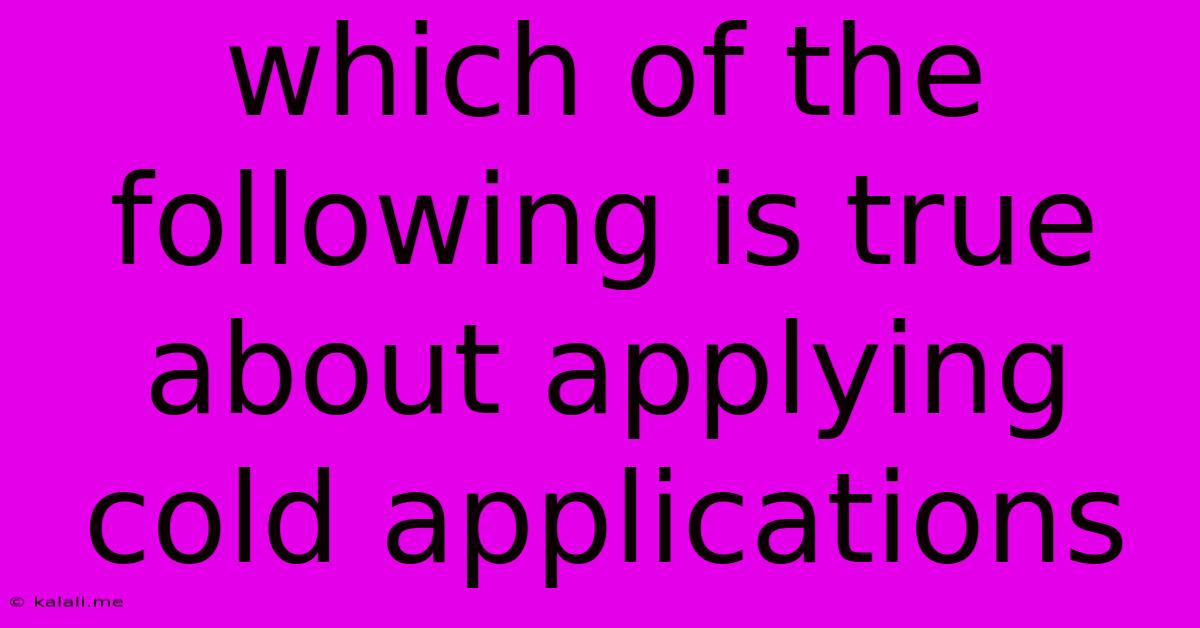Which Of The Following Is True About Applying Cold Applications
Kalali
Jun 14, 2025 · 3 min read

Table of Contents
Which of the Following is True About Applying Cold Applications? Understanding the Benefits and Cautions
Cold applications, such as ice packs or cold compresses, are a common first-aid treatment for various injuries and ailments. They offer a range of benefits, but it's crucial to understand how to apply them correctly to maximize their effectiveness and avoid potential harm. This article will delve into the truth about applying cold applications, separating fact from fiction. We'll explore their therapeutic uses, proper application techniques, and potential drawbacks.
What are Cold Applications and Why Use Them?
Cold applications involve applying something cold to the body, typically to reduce inflammation, pain, and swelling. This is achieved through vasoconstriction—the narrowing of blood vessels—which decreases blood flow to the affected area. This reduced blood flow helps to:
- Reduce Swelling: By limiting blood flow, cold applications minimize fluid leakage into the surrounding tissues, thus reducing swelling (edema).
- Decrease Pain: The numbing effect of cold helps to block pain signals from reaching the brain, providing temporary pain relief.
- Control Bleeding: In some cases, cold can help to constrict blood vessels and slow down minor bleeding.
Which of the Following Statements is True About Applying Cold Applications?
Let's examine some common statements about cold application and determine their accuracy:
Statement 1: Applying ice directly to the skin is always safe.
FALSE. Applying ice directly to the skin can cause frostbite or cold burns. Always wrap the ice pack in a thin towel or cloth before applying it to the skin.
Statement 2: Cold applications should be used for all types of injuries.
FALSE. While cold therapy is beneficial for many injuries like sprains, strains, and bruises, it's not suitable for all conditions. For example, applying cold to a severe frostbite injury could worsen the damage. Consult a medical professional for guidance on specific injuries.
Statement 3: Longer application times always lead to better results.
FALSE. Prolonged exposure to cold can lead to frostbite or cold burns. Follow the recommended application time, usually 15-20 minutes at a time, with breaks in between. Never leave a cold pack unattended.
Statement 4: Cold applications can help reduce muscle soreness after exercise.
TRUE. Cold therapy can help reduce inflammation and pain associated with delayed-onset muscle soreness (DOMS) after intense physical activity. Applying ice packs to sore muscles can provide temporary relief.
Statement 5: Cold applications should be avoided if you have poor circulation.
TRUE. Individuals with compromised circulation or peripheral artery disease (PAD) should exercise caution when using cold applications. The vasoconstriction effect could further restrict blood flow, potentially causing harm. Always consult a doctor before using cold therapy if you have circulation issues.
Best Practices for Applying Cold Applications:
- Wrap the ice pack: Never apply ice directly to the skin. Always use a thin towel or cloth as a barrier.
- Apply for 15-20 minutes: Apply the cold pack for 15-20 minutes at a time, then remove it for at least an hour before reapplying.
- Elevate the injured area: Elevating the injured area above the heart helps to reduce swelling.
- Monitor for adverse reactions: Watch for signs of frostbite, such as numbness, tingling, or discoloration of the skin. If you experience any adverse reactions, stop using the cold pack immediately.
- Consult a medical professional: If the pain persists or worsens, or if you have any concerns, consult a doctor or other healthcare professional.
By understanding the proper application techniques and potential risks associated with cold therapy, you can safely and effectively utilize this common first-aid treatment for a variety of conditions. Remember, seeking professional medical advice is always the best course of action when dealing with injuries or ailments.
Latest Posts
Latest Posts
-
Least Common Multiple Of 4 8 And 12
Jun 15, 2025
-
Difference Between A Square And Rhombus
Jun 15, 2025
-
Unit Weight Of Water In Kg M3
Jun 15, 2025
-
How To Balance Chemical Equations Calculator
Jun 15, 2025
-
Which Of The Following Describes Transpiration
Jun 15, 2025
Related Post
Thank you for visiting our website which covers about Which Of The Following Is True About Applying Cold Applications . We hope the information provided has been useful to you. Feel free to contact us if you have any questions or need further assistance. See you next time and don't miss to bookmark.